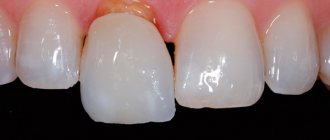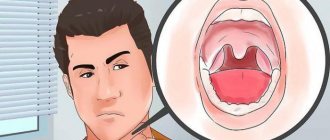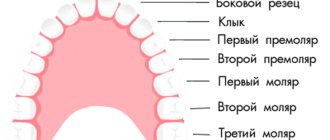Why is this happening?
Let's look at the probable causes of this problem:
- The crown does not fit tightly to the natural tooth, which leads to the smallest pieces of food getting under the artificial product. As a result, the leftover food begins to rot, which causes the bad smell.
- A tooth on which caries is actively developing is subject to prosthetics. Under the crown, further destruction of the unit is observed, sometimes this process is accompanied by an unpleasant odor.
- Using low-quality dental cement, which begins to oxidize upon contact with saliva.
- Poor quality oral hygiene. Sometimes the crown does not play a role at all, and bad breath is caused by poor brushing of the teeth.
How to get rid of bad breath
Some sensitive issues are not usually discussed even with close relatives. People tend to turn a blind eye and ignore them for a long time, especially if the solution requires consulting a specialist. In such a situation, many choose the path of least resistance - folk recipes and various remedies that can be used at home. As a rule, they are ineffective, but such a choice does not require much effort and suits the person until the problems reach frightening proportions.
The scenario described above is more than typical for the symptom discussed in this publication. Bad breath is not something to discuss. The rules of good manners do not allow others to point out the problem, and the person himself prefers to think that it is not so big.
In everyday life, this symptom of chronic somatic diseases or dental pathology is often described with the vague formulation “bad breath.” Doctors and dentists use the more correct and unambiguous term “halitosis.” Breath with a “smell” most often indicates the development of certain diseases. It is not necessary to discuss the situation with loved ones, but if bad breath appears, it is extremely important to undergo a diagnosis that will reveal the true causes of halitosis.
Causes
Not all causes of halitosis are a cause for concern. In a certain percentage of cases, it’s all about the banal consumption of certain foods or drinks that have pronounced aromatic properties. An example would be garlic, onions or fish - foods with a specific aroma. Exogenous causes include smoking. Tobacco often causes bad breath, which the smoker himself does not even notice. But these reasons are obvious, and it’s easy to fight them. It is more difficult (and more important!) to solve a problem that has no obvious causes.
In order to get rid of bad breath once and for all, which has been bothering you for a long time and is not associated with exogenous causes, it is important to find out what causes its appearance. Endogenous (internal) causes can be divided into two categories.
The first category is diseases of the oral cavity. It is oral disease that is the root of the problem in the vast majority of people with halitosis. Dental diseases that can lead to bad breath are discussed in more detail in the next section of the publication.
The second group of causes is formed by chronic diseases of the stomach, other parts and organs of the digestive system, and diseases of the endocrine organs. The greatest danger is diabetes mellitus, both type 1 and type 2. This endocrine pathology is characterized by the appearance of an “acetone” odor. It is caused by metabolic disorders: the patient’s body increases the formation of ketone bodies (organic compounds), which are excreted through the lungs and give the breath a specific “acetone” smell.
Parents should be wary of this symptom (smell of acetone). If a child develops a symptom, you should immediately consult a specialist and undergo an examination, a mandatory element of which is a glucose tolerance test and a blood sugar test.
Note that in rare cases, the unpleasant odor of acetone is associated with dietary habits. In recent years, the so-called ketone diet, which requires maximum restriction of carbohydrate intake, has become very popular. Its goal is to transition the body into a state of acidosis, in which there is an increased formation of ketone bodies. Because these organic substances are partially eliminated through the lungs, followers of the ketone diet often face the problem of bad breath.
Halitosis in dental pathology
Gastrointestinal diseases (gastritis, stomach ulcers), diabetes mellitus or the ketone diet are conditions that people are generally well aware of. The only exception is undiagnosed diabetes, so if the smell of acetone appears, it is extremely important to promptly seek qualified help.
If bad breath appears against the background of “complete well-being,” its causes should be sought in dental pathology. It is very important to understand that oral diseases are the main causes of halitosis in people without chronic endocrine or somatic pathology. If you are interested in the question of how to get rid of bad breath, carefully study this section of the publication. This way you can avoid common mistakes, forget about the problem forever and, most importantly, keep your teeth intact and healthy.
In diseases of the oral cavity (often they are not diagnosed, that is, the person may not be aware of the problem), the unpleasant odor has a specific, slightly “putrid” character. At first, a person notices the symptom, mainly after sleep, before carrying out morning hygiene procedures. Then the problem of bad breath becomes a constant companion, which causes serious concern.
Caries
What diseases provoke the appearance of halitosis? In the first place is caries. Carious tooth damage is accompanied by the development of pathogenic microflora. Bacteria produce toxins that cause inflammation in the oral cavity. In addition, bacteria emit gaseous substances, which themselves have an unpleasant odor.
The degree of carious lesion directly affects the severity of halitosis. The deeper the microorganisms penetrate into the tooth, the stronger the unpleasant odor. The problem can only be solved by complete removal of the affected tissue with restoration of the defective tooth.
The only right decision is to seek help from a specialist without any extra thought or doubt. Make an appointment with your dentist, otherwise the tooth will continue to decay. Once a critical amount of living tissue has been destroyed, restoring the tooth will require expensive orthopedic treatment.
Periodontitis, fistula in the gum
Purulent inflammation around the root apex is the result of untreated caries and pulpitis. An apical abscess can manifest itself as a symptom such as the formation of a fistula on the gum. A fistula is the external opening of a canal connecting a cyst to the oral cavity. Through the fistula, pus is released, which is accompanied by the appearance of a characteristic unpleasant odor.
Poor hygiene
Are there other causes of halitosis besides tooth decay? Undoubtedly. Bad breath can be the result of poor oral care. If a person brushes their teeth sporadically, or does it too quickly or not thoroughly enough, a bacterial film forms on the surface of the teeth. Over time, this soft film, which can be easily removed with a regular brush, becomes saturated with mineral salts. This forms hard stone on the teeth, which can no longer be removed with a brush.
The basis of dental plaque is bacteria, which release toxins and gaseous substances, causing inflammation of the oral mucosa. Due to these processes, the breath acquires an unpleasant odor.
Gingivitis, periodontitis
Hard dental plaque is a harbinger of dental caries and a number of other oral diseases. If you do nothing, sooner or later you will face more serious problems than halitosis. Many people begin to notice that their gums bleed during daily brushing. These are the first symptoms of gingivitis, in which an inflammatory process develops in the gum mucosa.
Gingivitis left untreated (or treated with home remedies that are ineffective) leads to the development of periodontitis, an oral disease that poses a real risk of tooth loss. At this point, many remember that it all started with poor hygiene and bad breath, and the problem was easily solved by hygienic teeth cleaning in the dental office.
How to get rid of bad breath?
Even today, in the age of maximum availability of information about various symptoms, their causes and treatment methods, many people continue to pose the question differently: how to get rid of bad breath at home? Is this possible, and if not, why?
Fresh breath, which is actively advertised by manufacturers of toothpastes and chewing gums, is an indicator of good hygiene and overall health of the oral cavity and teeth. Breathing is a kind of litmus test that allows us to understand how healthy we are and how attentive we are to personal hygiene.
Bad breath is a red flag and an indicator of serious problems. Problems not only with hygiene, but with oral health. It is possible to mask halitosis by chewing gum or regularly rinsing the mouth with special solutions, but this will not solve the problem.
How to eliminate bad breath if it is caused by stone formation with activation of pathogenic microflora? Stone is a mineralized plaque that is firmly fixed to the enamel. It is not possible to remove the stone yourself. This can only be done by a dentist using special equipment. Ultrasonic cleaning is used to remove tartar. Another technology for removing deposits is Air Flow.
Professional teeth cleaning is the most effective means of preventing caries, periodontitis, gingivitis and other dental diseases!
For gingivitis, professional teeth cleaning to remove hard deposits is also a mandatory stage of treatment. After cleaning the teeth, anti-inflammatory therapy is prescribed for 10 days. The patient should rinse the mouth with antiseptic solutions several times a day. After rinsing, special dental gels with an anti-inflammatory effect are applied to the gums.
In case of periodontitis, the above stages of treatment do not lose their relevance, but teeth cleaning is complicated by the fact that it is necessary to remove stone from periodontal pockets. This is difficult to do; the treatment is carried out by a doctor with a narrow specialization - a periodontist. In addition to anti-inflammatory drugs, antibiotics are often prescribed.
How to remove bad breath caused by caries? If the cause of “stale breath” is caries, there is no need to talk about the effectiveness of any methods for use at home. Science has not yet known cases of self-healing from this disease. The person who finds a way to cure tooth decay without the help of a dentist should be awarded a Nobel Prize.
Caries treatment is carried out in a dental clinic. The dentist removes all tissues affected by the carious process. If this is not done, a source of infection will remain, which will lead to further decay and destruction of the tooth.
After removing the carious defect, the tooth is restored with a composite polymer (a filling is placed). If caries is complicated by the development of pulpitis or periodontitis, the stage of depulpation, sanitation and subsequent sealing of the canals is added to the treatment protocols. Depulpation with root canal sealing increases the duration and cost of treatment, but it is necessary if you want to save the tooth.
To cure caries quickly and without extra costs, contact your dentist when the first symptoms appear, or better yet, schedule a consultation every six months for a preventive examination and professional teeth cleaning.
Bad breath after caries treatment
Some patients develop bad breath after caries treatment. As a rule, bad breath is accompanied by another symptom - local pain in the area of the projection of the treated tooth or the formation of a fistula in the gum. The condition should be considered as a complication that indicates poor quality dental care.
The cause of post-filling pain is the re-development of the infectious process in the deep tissues. This is caused by incomplete removal of carious tissues or poor isolation of the tooth during filling or sealing of canals. In the first case, pathogenic microorganisms remain in the tooth, in the second, saliva and bacteria get under the filling, which become a source of secondary infection.
To remove bad breath in such a situation, you need to undergo repeated treatment with unfilling of the root canals and sanitization of the source of infection. To avoid complications, contact dental centers with a good reputation and trust your oral health to qualified, conscientious and experienced specialists.
Prevention
If there is no unpleasant odor, its occurrence can be easily prevented. High-quality and regular cleaning of the oral cavity is enough. After eating, it is important to remove the smallest particles of food from the interdental spaces. To do this, you need to use dental floss, and then clean the lingual and outer surfaces of the teeth with a good brush, preferably with stiff bristles.
People with orthopedic (crowns, bridges) or orthodontic (braces) structures, as well as anomalies in the location of teeth in the form of crowding, may require additional tools for personal hygiene. Dentists strongly recommend that such patients purchase an irrigator with special attachments that ideally cleans crowns, braces, narrow interdental spaces and gum pockets.
It is good practice to have your teeth professionally cleaned with Air Flow regularly at your dentist's office to help prevent plaque from forming. Once every six months you need to make an appointment for preventive examinations with a dentist to detect caries at an early stage.
To receive individual recommendations regarding solving the problem of “stale breath,” sign up for a consultation with a medical dentist (Moscow).
When should you sound the alarm?
How to understand that the smell is associated specifically with dental prosthetics? In fact, it's simple. If halitosis is the cause of poor-quality crown installation, at least one of the following symptoms must additionally be present:
- Loose fit of the crown to the gum.
- The occurrence of swelling of soft tissues.
- Painful sensations under the crown.
- The gap between the gum and the beginning of the prosthesis has a dark, unusual color.
If at least one of the signs is observed, you should not wait for complications, immediately go to the dentist.
Symptoms and need for treatment
If the gums smell rotten, but there is no pain, a person often ignores this symptom for a long time, trying to hide the deficiency with chewing gum, lollipops, and toothpastes “for fresh breath.” However, if the problem is started, additional symptoms will arise that should not be ignored:
- swelling of soft tissues, the appearance of compactions or formations that are soft inside, and their contents gradually increase;
- fever without cold symptoms;
- sharp or aching pain radiating to the jaw and temple area;
- loss of appetite, insomnia, worsening mood;
- obvious facial asymmetry associated with edema;
- difficulties in chewing food, talking;
- loosening of teeth, exposure of roots.
It is important not to ignore these symptoms, but to consult a doctor immediately. The danger is that the smell of pus indicates infection of the areas. Fistulas can form on the mucous membranes, the rupture of which will lead to pus entering the body, which will cause serious damage to internal organs. Treatment of the problem at the initial stage will be as effective as possible, will allow you to avoid unnecessary expenses, and save teeth that can be damaged during purulent processes.
How to solve this problem?
At home, this situation can only be dealt with if the cause of the unpleasant odor is poor oral hygiene. Experts recommend using a medium-hard toothbrush, toothpaste, floss, irrigator and refreshing mouthwash. If the problem is not solved in this way, all that remains is to visit a dentist.
When you visit a specialist, you will most likely have to remove the crown. This way, the doctor will be able to understand what exactly caused the bad odor. If caries is detected, it is eliminated. To re-fix the crown, better cement compounds are used. If the cause of the smell was a medical mistake, the idea is that the work should be redone completely free of charge.
Is it possible to fight the unpleasant odor from under the crown?
Since the unpleasant smell is caused by rotting processes, while they continue, it is impossible to get rid of the smell. You can only reduce it a little during treatment. They can help:
- Mouth rinses. To do this, you can use special antiseptic solutions that your doctor will recommend. Decoctions of medicinal herbs, such as chamomile or oak, are also suitable.
- Professional hygiene. The denture must be removed and cleaned. If the crown was installed to treat partial edentia, we recommend professional cleaning.
- Careful daily oral hygiene. In addition to a toothbrush and toothpaste, you can use special devices. You can completely clean the oral cavity, including in hard-to-reach places, using an irrigator. The device delivers a stream of air under pressure, which completely cleans out any remaining food. To care for crowns and implants, special brushes are used - interproximal, beam. You can clean the spaces between teeth using floss and floss.
Preventive actions
In order to avoid such a nuisance, it is recommended to choose only a prestigious dental clinic for dental prosthetics, where competent specialists work. You should not enroll in unknown institutions or dentistry that does not provide the necessary documentation on the qualifications of specialists.
It is also necessary to strictly adhere to hygiene rules. Provide the necessary care twice a day: brushing teeth, using mouthwash and irrigator. If you feel that there is an unpleasant odor coming from under the crown, you should not delay your visit to the doctor to avoid possible complications.
Diagnostics
The main diagnostic method is examination. In this case, the doctor determines the extent of spread of the pathological process and obvious signs of the disease. Also, to determine the cause and hidden symptoms, the dentist collects the patient’s medical history.
Diagnostic methods also include:
- Hedonic research. It is carried out by the attending physician and allows you to assess the quality and degree of odor. The assessment is made using the Rosenberg scale from 0 to 5 points. But the method has a drawback - subjectivity.
- Measuring the amount of sulfur compounds contained in the air a patient breathes. The study is carried out using a special device.
- Microbiological research. Allows you to establish the type of microorganisms and select a drug if necessary.
After all the studies have been carried out, the doctor establishes a diagnosis, the cause of the disease and determines the course of treatment.
Symptoms of secondary caries
The main symptoms that may suggest the appearance of secondary caries are sensitivity to cold and hot foods, pain during brushing, darkening of the tooth near the filling, the filling itself or its edges.
These symptoms occur in the period from 3 months to six months after treatment of primary caries. If secondary caries has penetrated deeply, then aching pain occurs - this means that the caries has reached the nerve, and pulpitis begins. This is where you urgently need to see a dentist.
To definitely diagnose secondary caries, you need to take an x-ray of the affected tooth. An experienced doctor can diagnose it during a routine examination, but to find out for sure, it is better to take a picture.
Treatment
First of all, you should contact your dentist. Most often, the smell disappears after sanitation of the oral cavity, removal of stones and treatment of caries. If there are other causes of the pathology, the doctor refers the patient to a therapist. In this case, treatment is required for the disease that caused the unpleasant odor.
Dentists also recommend sticking to a healthy diet and avoiding foods that can cause odor. You should also give up bad habits.
To restore intestinal microflora, it is recommended to consume more fermented milk products.









